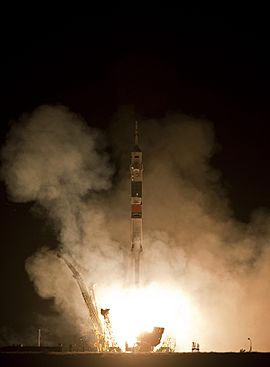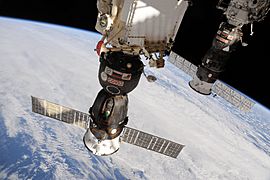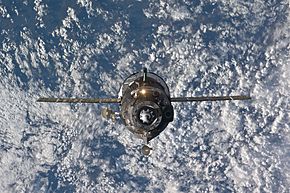Soyuz TMA-19 facts for kids
Soyuz TMA-19 was a space mission that carried astronauts to the International Space Station (ISS). It launched on June 15, 2010, with three astronauts who would live and work on the ISS for about six months as part of Expedition 24. This mission was the 106th time a Soyuz spacecraft had carried people into space. The Soyuz TMA-19 stayed docked to the space station. It served as an emergency escape vehicle for the astronauts during Expedition 24 and Expedition 25. The spacecraft returned to Kazakhstan on November 26, 2010. This was also the 100th mission to the International Space Station since it began being built in 1998.
| Mission type | Crewed mission to ISS |
|---|---|
| Operator | Roskosmos |
| Mission duration | 164 days |
| Spacecraft properties | |
| Spacecraft type | Soyuz-TMA 11F732 |
| Manufacturer | RKK Energia |
| Crew | |
| Crew size | 3 |
| Members | Fyodor Yurchikhin Shannon Walker Douglas H. Wheelock |
| Callsign | Olympus |
| Start of mission | |
| Launch date | 15 June 2010, 21:35 UTC |
| Rocket | Soyuz-FG |
| Launch site | Baikonur, Site 1/5 |
| End of mission | |
| Landing date | 26 November 2010, 04:46 UTC |
| Landing site | 84 km from the city of Arkalyk. |
| Orbital parameters | |
| Reference system | Geocentric orbit |
| Regime | Low Earth orbit |
| Inclination | 51.62° |
| Docking with ISS | |
| Docking port | Zvezda aft |
| Docking date | 17 June 2010 22:25 UTC |
| Undocking date | 28 June 2010 19:13 UTC |
| Time docked | 10 days, 20 hours and 48 minutes |
| Docking with ISS (Relocation) |
|
| Docking port | Rassvet nadir |
| Docking date | 28 June 2010 19:38 UTC |
| Undocking date | 26 November 2010 01:19 UTC |
| Time docked | 150 days, 5 hours and 41 minutes |
 Soyuz TMA-19 mission patch 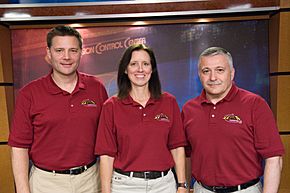 From left to right: Wheelock, Walker and Yurchikhin Soyuz programme
(Crewed missions) |
|
Contents
Who Were the Crew Members?
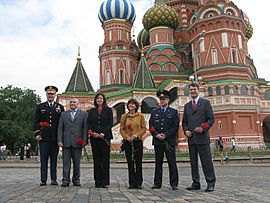
The crew for Soyuz TMA-19 was announced by NASA on November 21, 2008. The mission had three main astronauts. The Commander was Fyodor Yurchikhin from Roscosmos, Russia's space agency. This was his third trip to space.
The other two crew members were Shannon Walker and Douglas H. Wheelock from the United States' NASA. They were both Flight Engineers. For Douglas Wheelock, this was his second spaceflight. For Shannon Walker, it was her very first time in space.
| Position | Crew Member | |
|---|---|---|
| Commander | Expedition 24 Third spaceflight |
|
| Flight Engineer 1 | Expedition 24 First spaceflight |
|
| Flight Engineer 2 | Expedition 24 Second spaceflight |
|
Who Were the Backup Crew?
Sometimes, a backup crew is chosen in case the main crew cannot fly. For Soyuz TMA-19, the backup crew included:
| Position | Crew Member | |
|---|---|---|
| Commander | ||
| Flight Engineer 1 | ||
| Flight Engineer 2 | ||
How Did the Launch Happen?
The Soyuz TMA-19 spacecraft was launched by a Soyuz-FG rocket. It lifted off from Site 1/5 at the Baikonur Cosmodrome in Kazakhstan. The launch was successful on June 15, 2010, at 9:35 PM UTC.
After the spacecraft separated from the rocket, Moscow Mission Control Center took over. Nine minutes after launch, the Soyuz TMA-19 reached its first orbit. It was flying at an altitude between 200.16 and 259.16 kilometers. The spacecraft successfully opened its solar panels to get power. Its antennas also deployed for navigation and communication. Everything was working perfectly.
How Did It Dock with the ISS?
Soyuz TMA-19 connected with the International Space Station on June 17, 2010, at 10:25 PM UTC. It docked with the back port of the Zvezda module. Before docking, the ISS changed its position to make it easier for the Soyuz to connect.
The automatic docking system started working at 8:06 PM. The special Kurs docking systems on both the Soyuz and the ISS were turned on shortly after. The Soyuz TMA-19 then began its final approach to the station. About twenty minutes after connecting, strong hooks closed to secure the Soyuz to the station. Once this was done, the ISS went back to its normal flying position.
Why Did It Relocate?
On June 28, 2010, the three astronauts boarded their Soyuz TMA-19 spacecraft again. They undocked from the Zvezda module at 7:13 AM UTC. Just 25 minutes later, they re-docked the spacecraft to a new spot on the Rassvet module. This happened while the two spacecraft were flying over the coast of Western Africa.
The move was briefly delayed because of a small electrical problem on the space station. However, the flight went smoothly. This was the first time any spacecraft had ever docked with the Rassvet module. Moving the Soyuz freed up the Zvezda port for another spacecraft, Progress M-06M, to dock there later.
How Did It Return to Earth?
Soyuz TMA-19 undocked from the space station at 1:19 AM UTC on November 26, 2010. The part of the spacecraft that carries the crew landed in the central plains of Kazakhstan at 4:46 AM UTC. This was four days earlier than planned. The landing date was changed because of a big meeting happening in Kazakhstan.
On November 25, 2010, the crew got into the Soyuz TMA-19 to prepare for their return. They closed the hatch between the Soyuz and the station. Then, they put on their Sokol spacesuits and started turning on the Soyuz systems. The command to undock was given at 1:20 AM UTC. The physical separation from the station happened three minutes later.
After separating, the Soyuz fired its engines for 15 seconds to move away from the station. About two and a half hours later, at 3:55 AM UTC, the Soyuz performed a special maneuver to begin its descent to Earth. This burn lasted over four minutes. At an altitude of 140 kilometers, the spacecraft's computers separated the three parts of the Soyuz. The crew was in the Descent Module. The other two parts were safely released.
Three minutes after separation, the Descent Module began to enter Earth's atmosphere. Its heat shield protected the crew from the extreme heat. At about 10 kilometers above the ground, parachutes began to open. First, two small "pilot" parachutes deployed. Then, a larger drogue parachute opened, slowing the capsule down. Finally, the main parachutes deployed, slowing the descent even more.
The recovery teams spotted the Soyuz TMA-19 at about 4:36 AM UTC. At an altitude of five kilometers, the module's heat shield was released. The landing was confirmed at 4:46 AM UTC, marking the end of their 164-day journey. The recovery team helped the crew exit the capsule. Fyodor Yurchikhin was first out, followed by Shannon Walker and Douglas Wheelock.
After landing, the crew flew to Kostanay in Kazakhstan for a welcoming ceremony. Wheelock and Walker then took a NASA jet back to the Johnson Space Center in Houston, Texas. Yurchikhin returned to Star City, Russia, where the Yuri Gagarin Cosmonaut Training Center is located.
What Was the Mission Patch Like?
The design for the Soyuz TMA-19 mission patch came from a drawing by Evgeny Emelianov. He was the winner of a contest held by the Russian Federal Space Agency. His design shows the ISS and Earth, waiting for the crew to come back home.


